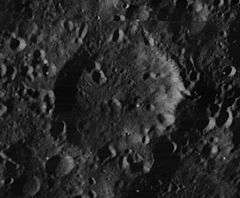Subbotin (crater)
Subbotin is a lunar impact crater that is located to the west of the larger crater Pavlov, and to the east-northeast of Lampland. Subbotin lies on the far side of the Moon, and can only be viewed from lunar orbit. It was named after the Soviet mathematician and astronomer Mikhail Subbotin.[1]
.png) LRO image | |
| Coordinates | 29.2°S 135.3°E |
|---|---|
| Diameter | 67 km |
| Depth | unknown |
| Colongitude | 225° at sunrise |
| Eponym | Mikhail F. Subbotin |


Since its formation, this crater has been heavily battered by smaller impacts, leaving the outer rim worn and marked by several small craterlets. This pattern of impact extends into the interior floor, where there are multiple small craterlets. A short chain of these impacts begins in the northwest part of the interior and curves back to extend across the northern rim.
Satellite craters
By convention these features are identified on lunar maps by placing the letter on the side of the crater midpoint that is closest to Subbotin.
| Subbotin | Latitude | Longitude | Diameter |
|---|---|---|---|
| J | 32.0° S | 138.1° E | 16 km |
| Q | 30.8° S | 134.3° E | 17 km |
| R | 31.3° S | 133.7° E | 16 km |
See also
- 1692 Subbotina, minor planet
References
- D., Schmadel, Lutz (2003). Dictionary of minor planet names. International Astronomical Union. (5th rev. & enl. ed.). Berlin: Springer. ISBN 9783540299257. OCLC 184958390.
- Andersson, L. E.; Whitaker, E. A. (1982). NASA Catalogue of Lunar Nomenclature. NASA RP-1097.CS1 maint: ref=harv (link)
- Blue, Jennifer (July 25, 2007). "Gazetteer of Planetary Nomenclature". USGS. Retrieved 2007-08-05.CS1 maint: ref=harv (link)
- Bussey, B.; Spudis, P. (2004). The Clementine Atlas of the Moon. New York: Cambridge University Press. ISBN 978-0-521-81528-4.CS1 maint: ref=harv (link)
- Cocks, Elijah E.; Cocks, Josiah C. (1995). Who's Who on the Moon: A Biographical Dictionary of Lunar Nomenclature. Tudor Publishers. ISBN 978-0-936389-27-1.CS1 maint: ref=harv (link)
- McDowell, Jonathan (July 15, 2007). "Lunar Nomenclature". Jonathan's Space Report. Retrieved 2007-10-24.CS1 maint: ref=harv (link)
- Menzel, D. H.; Minnaert, M.; Levin, B.; Dollfus, A.; Bell, B. (1971). "Report on Lunar Nomenclature by the Working Group of Commission 17 of the IAU". Space Science Reviews. 12 (2): 136–186. Bibcode:1971SSRv...12..136M. doi:10.1007/BF00171763.CS1 maint: ref=harv (link)
- Moore, Patrick (2001). On the Moon. Sterling Publishing Co. ISBN 978-0-304-35469-6.CS1 maint: ref=harv (link)
- Price, Fred W. (1988). The Moon Observer's Handbook. Cambridge University Press. ISBN 978-0-521-33500-3.CS1 maint: ref=harv (link)
- Rükl, Antonín (1990). Atlas of the Moon. Kalmbach Books. ISBN 978-0-913135-17-4.CS1 maint: ref=harv (link)
- Webb, Rev. T. W. (1962). Celestial Objects for Common Telescopes (6th revised ed.). Dover. ISBN 978-0-486-20917-3.CS1 maint: ref=harv (link)
- Whitaker, Ewen A. (1999). Mapping and Naming the Moon. Cambridge University Press. ISBN 978-0-521-62248-6.CS1 maint: ref=harv (link)
- Wlasuk, Peter T. (2000). Observing the Moon. Springer. ISBN 978-1-85233-193-1.CS1 maint: ref=harv (link)